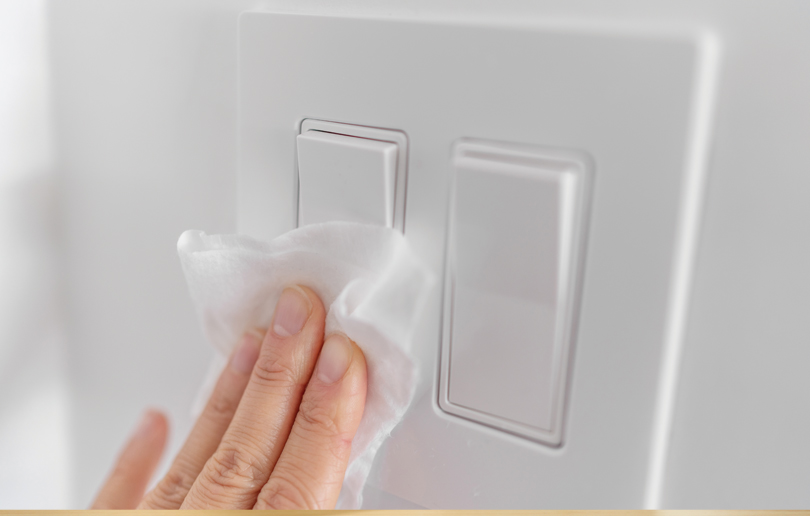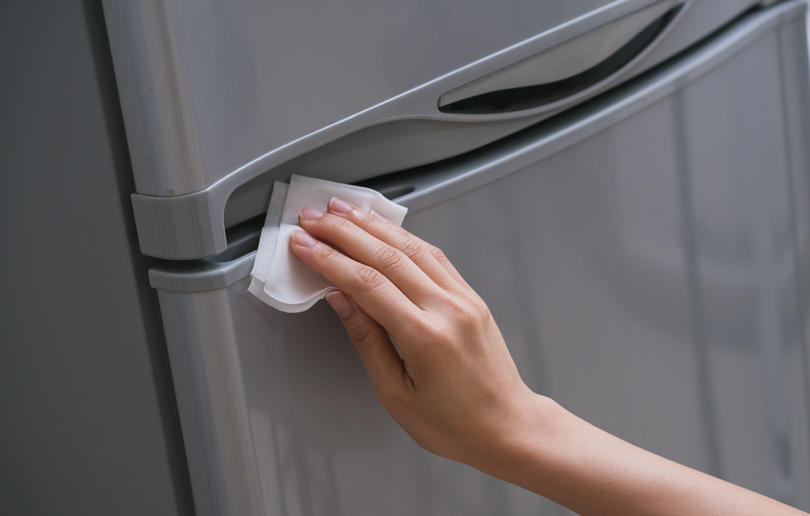Bacteria Hidden on Light Switches & Handles
Don’t Forget to clean away the bacteria hidden on light switches and handles! Light switches are not so obvious places for bacteria to gather, but researchers that have studied this find light switches are one of the filthiest surfaces in the home and pose a high risk of bacterial infection.

If you ever wondered how bacteria becomes hidden on light switches and handles, just imagine this scenario… Someone at home is running late and in a rush to leave the house. They quickly visit the washroom, hurriedly wash their hands and with a quick towel dry, they flick off the light. The last stop before leaving is to grab a bottle of cold water to take out into the heat with them! So they dash to the kitchen, switch on the light, grab a bottle from the fridge, slam the door shut before flicking off the AC, switching off the lights and leaving the house.
Let’s rewind this scenario and take a closer look at how this common scene could actually be spreading germs around the home. Without following the latest advice on personal hygiene, the things that are touched within this scene – and could spread bacteria are:
- Light switch
- Toilet seat
- Toilet roll
- Toilet flush handle / button
- Tap/faucet
- Towel
- Inside & outside bathroom door handles
- Kitchen light switch
- Fridge door handle and possibly a shelf, drawer or other products in the fridge
- AC controls
- Light switch closest to the front door
- Inside & outside front door handle
We cannot see the bacteria hidden on light switches and handles, but it is easy to see why one particular study found that the average light switch is crawling with 217 bacteria per square inch; and another found that light switches tested positive for coliform bacteria (fecal matter) and contained 112.7 bacterial colony forming units (CFUs) per square centimetre, as well as 122.7 CFU’s of aerobic bacteria (such as E.Coli), scoring them higher on the ‘crawling with germs’ scale than the average toilet seat. Don’t forget the plug and socket switches when you clean!
To clean light switches, plugs and plug sockets, never spray any liquid directly onto them. Instead, spray some disinfectant spray onto a sanitised kitchen towel, but make sure the kitchen towel is only slightly damp, not wet. (Sponges are not recommended for cleaning light switches, because there is too much danger of getting liquid under the switch, which can be extremely dangerous.)
Handles that are often overlooked
- Fridge & freezer: inside handles for compartments and the outside door handle
- Microwave: the ‘On’ button, door release and temperature dials
- Kettle: where you touch the lid to refill it and the handle itself
- Cupboard doors: frequently touched in food prep, don’t overlook them!
- Appliances & equipment: toaster, blender, electric beater or whisk, and pan handles
- Oven/stove knobs: including the overhead light and fan
Clean these handles and knobs frequently and use a new wipe for every spot instead of reusing the same one, otherwise you risk transferring bacteria from one spot to another.

The cleaning products themselves!
Have you ever prepared a meal by cutting meat or poultry, then taken the cutting board straight to the sink to wash it, in order to maintain good hygiene? Notice how you usually pick up the dish-washing detergent bottle in the middle. If you are using a disinfectant spray to clean something dirty, then notice how you grip the top of the bottle and place your fingers on the trigger to squeeze it.
It’s a good idea to spray some disinfectant onto a sanitised paper towel and also wipe the cleaning product bottles themselves.
Essential hygiene products
- Soap and water
- Bleach and water
- Sterilized kitchen roll (use with disinfectant sprays to wipe down all surfaces)
- Disinfecting wipes with at least 60% ethanol or 70% isopropanol
- Hand sanitizers with at least 60% ethanol
- Rubber gloves – if you are doing a lot of cleaning, choose a sanitized brand such as Fine Hygienic gloves that kills germs and viruses on contact.
If you sanitise all your handles and light switches, then get all the family members into the habit of washing their hands thoroughly and obeying the updated rules on personal and home hygiene, you’ll go a long way to minimising the risk of spreading bacteria and viruses at home.
FURTHER READING:
Where Bacteria Lurk in the Kitchen
Reducing the Risk of Virus Infection











Comments